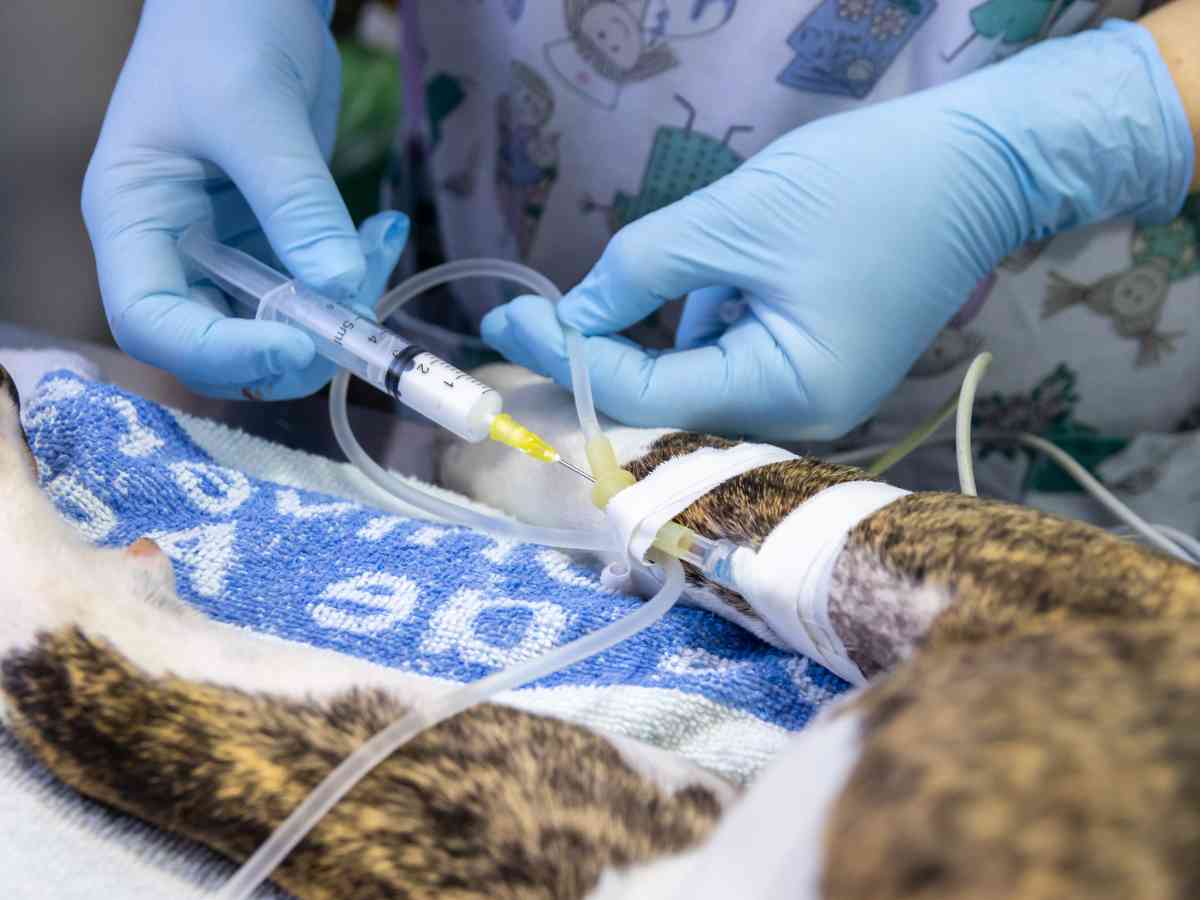Pancreatitis in dogs refers to the inflammation of the pancreas. It’s a vital organ that plays a dual role in your dog’s digestion and blood sugar regulation. When your dog’s pancreas becomes inflamed, it can’t perform its functions as effectively, which leads to a range of digestive and total-body symptoms. Pancreatitis in dogs can be chronic or acute, with varying degrees of severity, and if left untreated, can lead to significant health complications for your dog. Understanding how pancreatitis may affect your dog is important, as early detection and management are the way to help prevent serious outcomes.
Classic signs of pancreatitis in dogs
Pancreatitis in dogs is a condition that can be both sudden (acute) and severe, or slow-developing (chronic) and less intense, with symptoms including repeated episodes of vomiting, a decrease in appetite, abdominal pain that might show as discomfort or restlessness, weakness, lethargy, diarrhea, and fever. These symptoms might not all present at once, and dogs may exhibit only one or two of these signs in some cases. Particularly telling (and scary) behaviors include shaking or trembling, assuming a “praying” position that resembles the “downward dog” yoga pose, crying out in pain, or seeming unable to find a comfortable resting position.
What’s The Difference Between Acute And Chronic Pancreatitis In Dogs?
Acute and chronic pancreatitis in dogs represent two forms of the same condition, with differences in onset, severity, and potential long-term implications.
Acute pancreatitis happens quickly, almost out of the blue, showing symptoms that can range from mild to severe. This form of the condition often requires immediate veterinary attention due to the potential for life-threatening complications and its quick onset. Treatment for acute pancreatitis usually involves hospitalization, IV fluids for hydration, pain management, and sometimes, antibiotics if an infection is present. The primary goal is to manage the symptoms and prevent further damage to the pancreas and surrounding organs.
Chronic pancreatitis in dogs, on the other hand, develops more slowly and can be a consequence of repeated episodes of acute pancreatitis or continuous low-grade inflammation. Dogs with chronic pancreatitis may show more subtle or intermittent symptoms of pancreatitis, like occasional vomiting, colitis, and lack of appetite. Managing chronic pancreatitis often focuses on dietary changes, including a low-fat diet to prevent flare-ups, and may involve enzyme supplementation to aid digestion. Chronic pancreatitis can lead to significant damage to the pancreas over time, potentially resulting in diabetes or exocrine pancreatic insufficiency (EPI), where the pancreas fails to produce necessary digestive enzymes at all.
Early detection and intervention are key to managing both acute and chronic pancreatitis. Quick veterinary care can be life-saving for acute pancreatitis, while chronic pancreatitis requires ongoing management to maintain quality of life and prevent further pancreatic damage. In both cases, dietary management plays a crucial role in prevention and treatment, focusing on low-fat, easily digestible foods and avoiding high-fat diets that can exacerbate the condition.
What Causes Pancreatitis In Dogs?
Dogs with pancreatitis suffer because the digestive enzymes in their pancreas activate too early instead of in their small intestine, where they normally would in the digestive process. This premature activation leads to inflammation and damage to the pancreas and nearby organs. The situation gets worse because then your dog’s inflamed pancreas starts to digest itself essentially. This is extremely uncomfortable and potentially very dangerous to your dog.
Certain breeds are more susceptible to pancreatitis, including Miniature Schnauzers, Yorkshire Terriers, Cocker Spaniels, Dachshunds, Poodles, Bichon Frise, and Shetland Sheepdogs. Additionally, dogs with other health conditions like hypothyroidism, diabetes mellitus, or Cushing’s disease may have a higher risk of developing pancreatitis.
There are many possible causes of pancreatitis, ranging from high-fat diets to obesity, certain medications, or even genetic predisposition. Other risk factors include dietary indiscretions (eating something(s) they shouldn’t), hypothyroidism, severe trauma, and diabetes mellitus. Some dogs might suffer from pancreatitis after they are exposed to toxins, battle infections, have cancer affecting the pancreas, or have abdominal trauma.
How Do Vets Diagnose Pancreatitis In Dogs?
The diagnosis process for pancreatitis in dogs is pretty comprehensive, and your vet will review your dog’s history and current symptoms. This initial assessment what guides them for further diagnostic steps, such as:
- Blood Tests: Blood work is a foundational step in diagnosing pancreatitis. Veterinarians look for elevated levels of pancreatic enzymes (amylase and lipase), along with other indicators like increased white blood cell count or abnormalities that suggest inflammation and organ stress. A specific blood test, the canine pancreatic lipase immunoreactivity (cPL) test, especially indicates pancreatitis if elevated.
- Ultrasound: An abdominal ultrasound is one of the most accurate methods for diagnosing pancreatitis. This non-invasive technique allows veterinarians to visually assess the pancreas and surrounding areas for signs of inflammation, swelling, or other abnormalities. It can also help rule out other causes of the dog’s symptoms, like blockages or tumors.
- Additional Diagnostic Imaging: In some cases, further imaging like X-rays may be used to eliminate the possibility of other conditions that copy pancreatitis symptoms, like an intestinal blockage.
- Physical Examination: A comprehensive physical exam, including palpation of the abdomen, can show tenderness or pain in the pancreatic area, which could indicate pancreatitis in dogs.
The diagnostic process is important to confirm and determine the severity of pancreatitis. This can significantly impact the treatment approach. The combination of blood tests, imaging, and a thorough health check allows veterinarians to make an informed diagnosis and tailor a treatment plan suited to an individual dog’s needs.
How To Treat Pancreatitis In Dogs
Treatment focuses on supportive care to manage dehydration, pain, and nausea while allowing the pancreas time to recover. This might include fluid therapy, anti-nausea medication, pain management, gastric acid suppression, and a low-fat diet. In some cases, dogs that cannot eat may require feeding tubes. As we said, hospitalization is often necessary for acute cases to provide more intensive care.
Prevention and careful management are key to minimizing the risks associated with pancreatitis. This includes maintaining a healthy diet for your dog, avoiding high-fat foods, and ensuring they do not get into the garbage or eat table scraps that could trigger a pancreatitis episode. Even though not all cases of pancreatitis can be prevented, especially those where the cause is unknown, careful attention and diligence to good nutrition and exercise veterinary care can significantly reduce the risks and impact to your dog.
What Is the Long Term Treatment And Prognosis for Pancreatitis in Dogs?
The treatment of pancreatitis in dogs is primarily supportive and varies based on the severity of the condition. The goal is usually to alleviate symptoms, prevent complications, and address the underlying causes to promote the best recovery. Some focuses include:
Hydration
- Fluid Therapy: Maintaining hydration is critical, especially for dogs experiencing vomiting and diarrhea. Intravenous (IV) fluid therapy or subcutaneous fluids are commonly used to remedy dehydration and electrolyte imbalances.
Diet Management
- Dietary Changes: A low-fat diet is essential for dogs recovering from pancreatitis. In the initial stages, dogs might need to fast for a short period to rest their pancreas, and then begin back on a diet of bland, low-fat food that’s easy to digest. In the long term, dogs may require a permanent switch to a low-fat diet to prevent recurrence.
Medication
- Pain Management: Pain relief medications are often prescribed because pancreatitis can be painful. Options include anti-inflammatories and more potent painkillers for severe cases.
- Anti-nausea Medication: Vets may prescribe antiemetic drugs to help with vomiting and nausea.
- Stomach Protectants: These medicines help reduce acid production and protect the stomach lining, making the gastrointestinal tract more comfortable for your dog.
Hospitalization
- Severe Cases: Dogs with severe pancreatitis often require hospitalization to provide intensive care, including 24-hour monitoring, IV fluids, and more aggressive treatment for pain and nausea. Depending on the dog’s response to treatment, hospital stays can vary from several days to weeks.
Long-Term Management And Prognosis
- Monitoring and Management: After recovering from an acute episode, dogs with pancreatitis need ongoing management to prevent recurrence. This includes maintaining a strict diet, regular vet check-ups, and monitoring for any signs of recurrence or complications like diabetes or exocrine pancreatic insufficiency (EPI).
The prognosis for dogs with pancreatitis really varies with the severity of the disease and how quickly you get a handle on it. While many dogs recover with appropriate care, pancreatitis can reoccur, so it’s important to make lifestyle adjustments and addressing nutrition and dietary intake priorities.
Dietary Management For Pancreatitis In Dogs
Dietary management and prevention play key roles in treating and preventing dogs’ pancreatitis. A carefully selected diet, regular exercise, and proper weight management can significantly reduce the risk of pancreatitis flare-ups. Here’s how you can incorporate these strategies:
Preventive Diets
- Low-Fat Diet: Since high-fat foods are a major trigger for pancreatitis, feeding your dog a low-fat diet is super important. Look for dog foods specifically labeled as low-fat and stay away from unnecessary or empty calories.
- Consistent, Balanced Nutrition: Avoid sudden changes in your dog’s diet, which may upset their digestive system. Instead, shoot for a balanced diet that meets all their nutritional requirements without unnecessary fats.
Nutritional Advice
- Avoid Unhealthy Human Food: We know, we know…it’s hard. But, unhealthy human foods, especially some that are high in fat, can pose a significant risk for dogs prone to pancreatitis. Foods like fatty scraps, fatty meats, or any rich, processed food should be kept away from your dog.
- Proper Portion Control: Overfeeding can contribute to obesity, which is a risk factor for pancreatitis. Ensuring your dog is fed the right amount of food for their size, age, and activity level can help maintain a healthy weight.
Regular Exercise
- Routine Physical Activity: Regular exercise helps keep your dog at a healthy weight and supports overall digestive health. Tailor the exercise to your dog’s breed, age, and physical condition, so that you have a better chance of it being consistent and regular exercise for them.
Weight Management
- Monitor Weight Closely: Keep a close eye on your dog’s weight, as obesity is a significant risk factor for pancreatitis.
- Weight Loss Plan: Consider a weight loss plan if your dog is overweight. This might include adjusting their diet to lower-calorie food and increasing their exercise gradually.
Prevention is key to managing pancreatitis in dogs. A combination of a balanced diet, regular exercise, and careful weight management can significantly reduce the risk of your dog developing this painful condition. As always, we recommend you check with your veterinarian for personalized advice if the need arises.


